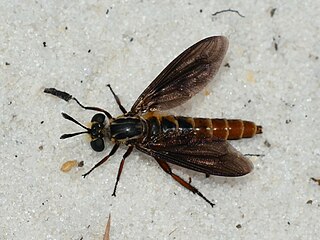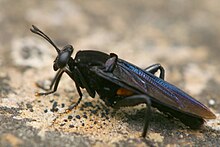
The Mydidae, or Mydas flies, are a cosmopolitan family of flies. It is a small family, with about 471 species described. They are generally large in size, including the largest known fly, Gauromydas heros. Many of the species, in addition to their large size, are mimics of stinging hymenopterans, especially wasps. Most mydids are found in arid and semiarid regions of the world, but they are also found in other habitats.
Opomydas is a genus of flies in the family Mydidae.

Nemomydas is a genus of flies in the family Mydidae.
Mapinguari is a genus of flies in the family Mydidae.
Ectyphinae is a subfamily of mydas flies in the family Mydidae. There are at least four genera in Ectyphinae.

Leptomydinae is a subfamily of mydas flies in the family Mydidae.

Mydas is a genus of flies in the family Mydidae.
Mydas tibialis, the golden legged mydas fly, is a species of mydas flies in the family Mydidae
Rhaphiomidas parkeri is a species of mydas flies.
Rhaphiomidas aitkeni is a species of mydas flies.

Rhaphiomidas terminatus, the flower-loving fly, is a species of mydas fly. It is endemic to California.
Pseudonomoneura tinkhami is a species of mydas flies.
Messiasia is a genus of flies in the family Mydidae.
Pseudonomoneura californica is a species of mydas flies.

Gauromydas is a genus of flies in the family Mydidae.
Baliomydas is a genus of flies in the family Mydidae.
Rhopaliinae is a subfamily of mydas flies in the family Mydidae.
Mitrodetus dentitarsis is a species of mydas flies in the family Mydidae.
Rhaphiomidas maehleri is a species of mydas flies.
Rhaphiomidas painteri is a species of mydas flies.






